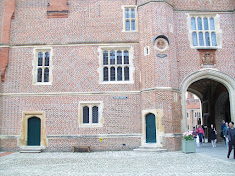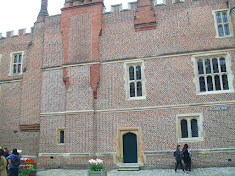Two days after my last sojourn, it was time to visit some filming locations close to home. Catching a bus to nearby Kingston, it was a fifteen minute train journey to Kempton Park.
The Kempton Park Pumping Station was established by the New River Company in 1897 to purify water abstracted from the River Thames at Staines, and pump it to service reservoirs in North London for supply to Central and East London. Construction began in 1900 and took six years to complete, by which time the New River Company and the seven other private water companies of London had been amalgamated to form the Metropolitan Water Board (MWB). In the 1920s, the MWB built a new engine house containing two triple-expansion steam pumping engines, named the ‘Sir William Prescott’ and Lady Bessie Prescott’ engines (after the Chairman of MWB and his wife). These engines which each weigh 800 tons and are 62 feet high cost £94,000 and were inaugurated in 1929, and decommissioned in 1980. The ill-fated RMS Titanic had engines similar to those at Kempton, and the two engines have appeared in several films about the ship, including ‘SOS Titanic’ (1979), ‘Saving the Titanic (2012), and the reason for my visit, ‘Holmes & Watson’ (2018), where Holmes rescues Watson from a gear-wheel in the Titanic engine room.
_3%20%5BHolmes%20&%20Watson%202018%5D.JPG)
_4%20%5BHolmes%20&%20Watson%202018%5D.JPG)
A guidebook was free with entry, and so having taken photos of the parts used in the film, I made my way around the numbered stops, taking a large number of photos of all parts of the large engines. Having done so, one of the volunteers took me right to the top of one of the engines, which was fine until he asked me if I was scared of heights, and which point minor vertigo set in. I then popped outside to take some photos of the exterior of the building as the pumping station was also used for the exterior shots of the Scrumptious Sweet Company factory in the 1968 classic family film ‘Chitty Chitty Bang Bang’.



Back in the museum, I purchased two postcards, before asking to be let back out of the side gate. After a swift walk back to the station, I was soon back in central Kingston where I had some lunch, before catching a bus to my second filming location of the day, Hampton Court Palace, which was very busy as I had accidentally chosen to visit on the penultimate day of the Hampton Court Tulip Festival.
Hampton Court Palace is a Grade I listed royal palace twelve miles upstream of central London on the River Thames. The building of the palace began in 1514 for Cardinal Thomas Wolsey, the chief minister of Henry VIII. In 1529, as Wolsey fell from favour, the cardinal gave the palace to the king to check his disgrace. The palace went on to become one of Henry's most favoured residences; soon after acquiring the property, he arranged for it to be enlarged so that it might more easily accommodate his sizeable retinue of courtiers. The palace is currently in the possession of King Charles III and the Crown.
The Palace is a regular location for filming, with films including ‘Pirates of the Caribbean: On Stranger Tides’ (2011), ‘Cinderella’(2015) and ‘Mamma Mia!: Here We Go Again’ (2018), being filmed there. However, it was in search of locations used in ‘Sherlock Holmes: A Game of Shadows’ (2011) and ‘Holmes and Watson’ again, that I had attended, using a voucher deal.
Having my ticket scanned, I walked all the way through the palace courtyards to the far side of the palace, and the Great Fountain Garden which was formerly part of Henry VIII’s hunting park, which I initially believed had been the filming location for the Anglo-American Exhibition in ‘Holmes and Watson’. However, moving to the left of the building, I found myself in the Privy Garden which matched the screenshots that I had printed off perfectly.

This garden is a restoration of William III's baroque Privy Garden of 1702. William III died before the garden was completely finished, which meant all the gardeners and workmen were frightened of not being paid. They therefore submitted the fullest possible accounts of their work, which allowed palace gardeners to restore the grounds using the original plant varieties and the hornbeam bower and statues which were all part of the King's original design. The workmen's accounts were further corroborated by archaeological evidence and historic garden plans. The wrought iron screens, designed and built by Jean Tijou for William III, stand at the river end.
I then wandered around the courtyards trying to find one that matched screenshots of Kings’ College - Cambridge (Moriarty’s college) in ‘Sherlock Holmes: A Game of Shadows’. Eventually I asked one of the attendants, who after looking at the photo stated that it looked like Clock Court. Making their way there, I found the exact spot, including Anne Boleyn’s gateway.


Clock Court is at the heart of the palace, and is named after the extraordinary Astronomical Clock mounted high on Anne Boleyn’s Gatehouse, the palace’s middle gateway. The clock’s complex gears and gilded dials, made in 1540, depict a medieval world in which the sun orbits the earth, and incorporates a great bell inherited from the late-medieval manor house that once stood on the site.
All locations identified and photographed, I bought a postcard of the South Side of the palace and a guidebook, spending a further two hours exploring Henry VIII’s Apartments and Kitchens, William III’s Apartments, the Georgian rooms, and the Cumberland Art Gallery, before decamping to the most expensive tea-room in the world (£5.50-£6.50 for a slice of cake), where I managed with just a mug of Hot Chocolate.
Making my way out of the palace, I caught a bus back into Central Kingston, and then home.

_1%20%5BHolmes%20&%20Watson%202018%5D.JPG)
_2%20%5BHolmes%20&%20Watson%202018%5D.JPG)

No comments:
Post a Comment